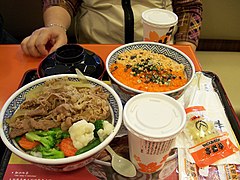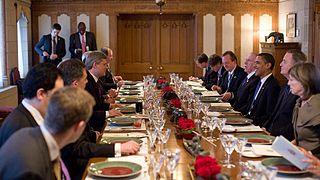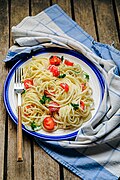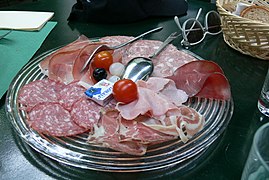Lunch
| Part of a series on |
| Meals |
|---|
 |
| Meals |
| Components and courses |
| Related concepts |
|
Lunch is a meal eaten around the middle of the day.[1] It is commonly the second meal of the day, after breakfast, and varies in size by culture and region.
Etymology

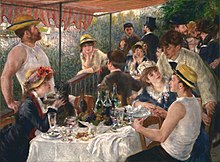

According to the Oxford English Dictionary (OED), the etymology of lunch is uncertain. It may have evolved from lump in a similar way to hunch, a derivative of hump, and bunch, a derivative of bump. Alternatively, it may have evolved from the Spanish lonja, meaning 'slice of ham'. It was first recorded in 1591 with the meaning 'thick piece, hunk' as in "lunch of bacon". The modern definition was first recorded in 1829.[2]
Luncheon (
History
Tastes in food, menu items, and meal periods have changed dramatically over time. During the Middle Ages, the main meal of the day, then called dinner, for almost everyone, took place late in the morning after several hours of work, when there was no need for artificial lighting. In the early to mid-17th century, the meal could be any time between late morning and mid-afternoon.
During the late 17th and 18th centuries, this meal was gradually pushed back into the evening, creating a greater time gap between breakfast and dinner. A meal called lunch came to fill the gap.
Until the early 19th century, luncheon was generally reserved for the ladies, who would often have lunch with one another when their husbands were out. The meal was often relatively light, and often included left-overs from the previous night's dinner, which were often plentiful. As late as 1945,
Beginning in the 1840s,
The remains of cold joints, nicely garnished, a few sweets, or a little hashed meat, poultry, or game, are the usual articles placed on the table for luncheon, with bread and cheese, biscuits, butter, etc. If a substantial meal is desired,
mutton chops may be served, as also veal cutlets, kidneys... In families where there is a nursery, the mistress of the house often partakes of the meal with the children and makes it her luncheon. In the summer, a few dishes of fresh fruit should be added to the luncheon, or, instead of this, a compote of fruit or fruit tart or pudding.[6]
Modern
With the growth of industrialisation in the 19th century, male workers began to work long shifts at the factory, severely disrupting the age-old eating habits of rural life. Initially, workers were sent home for a quick dinner provided by their wives, but as the workplace was moved farther from home, working men took to giving themselves something portable to eat during a break in the middle of the day.
The lunch meal slowly became institutionalised in England when workers with long and fixed-hour jobs at the factory were eventually given an hour off work to eat lunch and thus gain strength for the afternoon shift. Stalls and later chop houses near the factories began to provide mass-produced food for the working class, and the meal soon became an established part of the daily routine, remaining so to this day.[7]
In many countries and regions, lunch is the dinner or main meal.
Asia
A traditional Bengali lunch is a seven-
In China today, lunch is not nearly as complicated as it was before industrialisation. Rice,
Australia
In Australia, a light meal eaten in the period between 10:30 am and noon is considered
Europe
Western



Lunch in Denmark, referred to as frokost,[9] is a light meal. Often it includes rye bread with different toppings such as liver pâté, herring, and cheese.[10][11][12] Smørrebrød is a Danish lunch delicacy that is often used for business meetings or special events.


In Finland, lunch is a full hot meal,[a] served as one course, sometimes with small salads and desserts. Dishes are diverse, ranging from meat or fish courses to soups that are heavy enough to constitute a meal.[14]
In France, the midday meal is taken between noon and 2:00 p.m.[15]
In Italy, lunch is taken around 12:30 in the north and at 2:00 p.m. in the center south; it is a full meal but is lighter than supper.
In Germany, lunch was traditionally the main meal of the day.[b] It is traditionally a substantial hot meal, sometimes with additional courses like soup and dessert. It is usually a savoury dish consisting of protein (e.g., meat), starchy foods (e.g., potatoes), and vegetables or salad. Casseroles and stews are popular as well. There are a few sweet dishes like Germknödel or rice pudding that can serve as a main course, too. Lunch is called Mittagessen – literally, "midday's food".
In the Netherlands, Belgium, and Norway, it is common to eat
, some fruit or soup. It is eaten around noon, during a lunch break.In Portugal, lunch (almoço in Portuguese) consists of a full hot meal, similar to dinner, usually with soup, meat or fish course, and dessert. It is served between noon and 2:00 p.m. It is the main meal of the day throughout the country. The Portuguese word lanches derives from the English word "lunch", but it refers to a lighter meal or snack taken during the afternoon (around 5 pm) due to the fact that, traditionally, Portuguese dinner is served at a later hour than in English-speaking countries.
In Spain, the midday meal, "lunch" takes place between 1:00 and 3:00 p.m. and is effectively dinner, (the main meal of the day); in contrast, supper usually begins between 8:30 and 10:00 p.m. Being the main meal of the day everywhere, it usually consists of a three-course meal: the first course usually consists of an appetizer; the main course of a more elaborate dish, usually meat- or fish-based; the dessert of something sweet, often accompanied by a coffee or small amounts of spirits. Most places of work have a complete restaurant with a lunch break of at least an hour. Spanish schools also have a full restaurant, and students have a one-hour break. Three courses are standard practice at home, workplace, and schools. Most small shops close for between two and four hours – usually between 1:30 to 4:30 p.m. – to allow to go home for a full lunch.
In Sweden, lunch is usually a full hot meal, much as in Finland.[a]
In the United Kingdom, except on Sundays, lunch is often a small meal designed to stave off hunger until returning home from work and eating dinner. It is usually eaten early in the afternoon.[17] Lunch is often purveyed and consumed in pubs.[18] Pub lunch dishes include fish and chips, ploughman's lunch and others.[17] But on Sundays, it is usually the main meal, and typically the largest and most formal meal of the week, to which family or other guests may be invited. It traditionally centres on a Sunday roast joint of meat. It may be served rather later than a weekday lunch, or not.
Central
In Hungary, lunch is traditionally the main meal of the day,[19] following a leves (soup).
In Poland, the main meal of the day (called obiad) is traditionally eaten between 1:00 pm and 5:00 pm,[c] and consists of a soup and a main dish. Most Poles equate the English word "lunch" with "obiad" because it is the second of the three main meals of the day; śniadanie (breakfast), obiad (lunch/dinner) and kolacja (dinner/supper). There is another meal eaten by some called drugie śniadanie, which means "second breakfast". Drugie śniadanie is eaten around 10:00 am and is a light snack, usually consisting of sandwiches, salad, or a thin soup.
In Romania, lunch (prânz in Romanian) is the main hot meal of the day.[21] Lunch normally consists of two dishes: usually, the first course is a soup and the second course, the main course, often consists of meat accompanied by potato, rice or pasta (garnitură).[citation needed] Traditionally, people used to bake and eat desserts, but nowadays it is less common. On Sundays, the lunch is more consistent and is usually accompanied by an appetiser or salad.
Eastern
In Russia, the midday meal is taken in the afternoon. Usually, lunch is the biggest meal[d] and consists of a first course, usually a soup, and a second course which would be meat and a garnish. Tea is standard.
In Bosnia and Herzegovina, lunch is the day's main meal. It is traditionally a substantial hot meal, sometimes with additional courses like soup and dessert. It is usually a savoury dish, consisting of protein (such as meat), starchy foods (such as potatoes), and a vegetable or salad. It is usually eaten around 2:00 pm.
In Bulgaria lunch is usually eaten between 12:00 PM – 14:00 PM. In the capital of Sofia, people usually order takeaway because lunch breaks are too short to go in place. In other areas, Bulgarians often have salad as first meal and a dish from the national cuisine as second one.[23]
Middle East
In West Asia (Middle East) and in most Arab countries, lunch is eaten before 12:00 pm, usually between 9am and 12:00 pm and is the main meal of the day. It usually consists of meat, rice, vegetables and sauces and is sometimes but not always followed by dessert. Lunch is also eaten as a light meal at times in the Middle East, such as when children arrive at home from school while the parents are still out working.[24] Water is commonly served, which may be iced, and other beverages such as soft drinks or yogurt drinks are also consumed.[24]
North America
In the United States and Canada, lunch is usually a moderately sized meal generally eaten between 11 and 1. During the
In
South America
In Argentina, lunch is usually the main meal of the day, and normally takes place between noon and 2:00 p.m. People usually eat a wide variety of foods,[27][e] such as chicken, beef, pasta, salads, and a drink like water, soda or wine, and some dessert. Although at work, people usually take a fast meal which can consist of a sandwich brought from home or bought as fast food.
In Brazil, lunch is the main meal of the day,[f] taking place between 11:30 a.m. and 2:00 p.m. Brazilians usually eat rice with beans, salad, french fries, some kind of meat or pasta dishes, with juice or soft drinks. The kind of food may vary from region to region. Fast and simpler meals (sandwich, etc.) are common during weekdays. After the meal, some kind of dessert or coffee are also common.
Workdays
Since lunch typically falls in the early-middle of the
Gallery
-
An example of South Indian lunch
-
An example of North Indian lunch
-
Lunch foods at a Japanese restaurant in Hong Kong
-
phở, commonly served as lunch
-
US President Barack Obama and Canadian Prime Minister Stephen Harper with aides during a working luncheon in the Canadian Parliament in Ottawa, Ontario, in 2009
-
A Polish Easter lunch
-
American lunch of a hamburger and French fries
-
Homemade open sandwich, Denmark
-
Homemade Vegetable pasta
-
A platter of lunch meats
-
Swordfish lunch
-
Mushroom with salad lunch
-
Some Brazilian lunch foods
-
Homemade lunch in the lunchboxes
-
Fish and chips served for lunch at a restaurant in Finland
See also
- Break (work)
- Free lunch
- Lunch box
- Lunch counter
- Lunch lady
- Lunch meat
- Mahlzeit (German salutation)
- National School Lunch Act
- Plate lunch
- No such thing as a free lunch
Notes
- ^ a b "In Norway and Denmark the common lunch is based on sandwiches, whereas in Finland and Sweden the hot lunch is the norm."[13]
- ^ "Traditionally, lunch would be the main meal of the day. In the domestic arena, modern working practices have changed this considerably, although many restaurants still tout lunchtime dishes or a fixed lunch menu Gedeck or Tagesmenü."[16]
- ^ "Obiad is closer to a Western dinner, but the timing is more like lunch. You could say it's a dinner at lunchtime."[20]
- ^ "Lunch, according to an earlier Russian tradition, was the main meal of the day. A light lunch is usually taken at work."[22]
- ^ "Lunch and dinner are both hearty and for prosperous urban families may include a soup, an order of cold meat, a main course of meat with potatoes and green vegetables, a salad, and a dessert."[28]
- ^ "In most of Brazil, the big meal of the day is served at noon."[29]
References
- ISBN 978-0-19-104072-6.
- ^ a b "lunch, n.2". Oxford English Dictionary (Online ed.). Oxford University Press. (Subscription or participating institution membership required.)
- ^ "luncheon, n.". Oxford English Dictionary (Online ed.). Oxford University Press. (Subscription or participating institution membership required.)
- ISBN 9780191040726.
- ^ a b c McMillan, Sherry (2001). "What Time is Dinner?". www.history-magazine.com. Archived from the original on 8 December 2017. Retrieved 11 August 2007.
- ^ The Book of Household Management. Farrar, Straus, and Giroux. 1861. p. 959.
- ^ "Breakfast, lunch and dinner: Have we always eaten them?". BBC News. 15 November 2012. Retrieved 15 March 2016.
- ISBN 0-395-78032-2. Retrieved 13 March 2016.
- ISBN 978-90-76078-73-1. Retrieved 15 March 2016.
- ISBN 978-0-313-37626-9. Retrieved 15 March 2016.
- ISBN 978-1-84537-634-5.
- ISBN 978-1-4299-2902-8.
- ISBN 978-92-893-0658-4. Retrieved 15 March 2016.
- ISBN 978-0-89774-735-6.
- ISBN 978-0-313-32797-1. Retrieved 15 March 2016.
- ISBN 978-1-74059-988-7. Retrieved 15 March 2016.
- ^ ISBN 978-0-7618-2846-4.
- ISBN 978-0-7618-2846-4. Retrieved 15 March 2016.
- ISBN 978-1-4422-2731-6. Retrieved 15 March 2016.
- ISBN 978-1-74104-479-9. Retrieved 15 March 2016.
- ISBN 978-0-8368-2367-7. Retrieved 15 March 2016.
- ISBN 978-0-313-37626-9. Retrieved 15 March 2016.
- ^ Oprea, T. (2017). What the Locals Eat: A Typical Day's Food in Bulgaria. Culture trip.
- ^ ISBN 978-0-313-32956-2. Retrieved 15 March 2016.
- ^ Staff writer (30 September 2010). "The Return of the Three-Martini Lunch". Bloomberg. Retrieved 14 March 2016.
- ^ Jim Probasco (8 October 2021). "House Puts 'Three-Martini Lunch' Tax Break Back on the Table". Investopedia. Retrieved 23 October 2023.
- ISBN 978-1-885073-75-4.
- ^ Weil, T.E.; Munson, F.P. (1974). Area handbook for Argentina. Pamphlet. Supt. of Docs., U.S. Govt. Print. Off. p. 135.
- ISBN 978-1-55863-265-3.
External links
- Chisholm, Hugh, ed. (1911). . Encyclopædia Britannica (11th ed.). Cambridge University Press.
- Cookbook – Wikibooks



